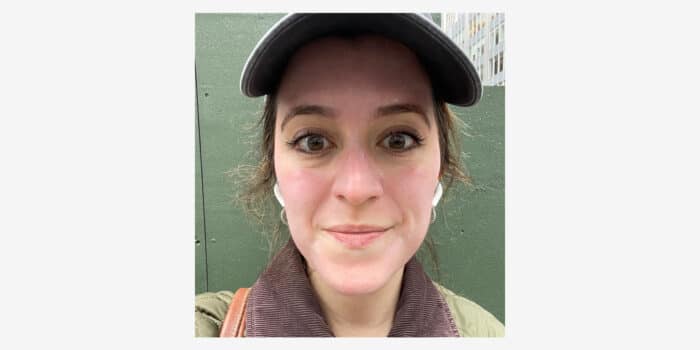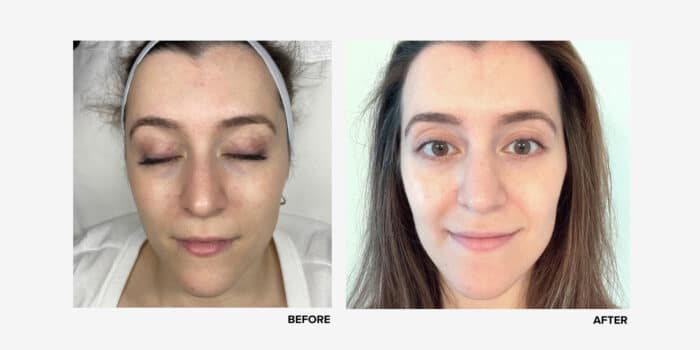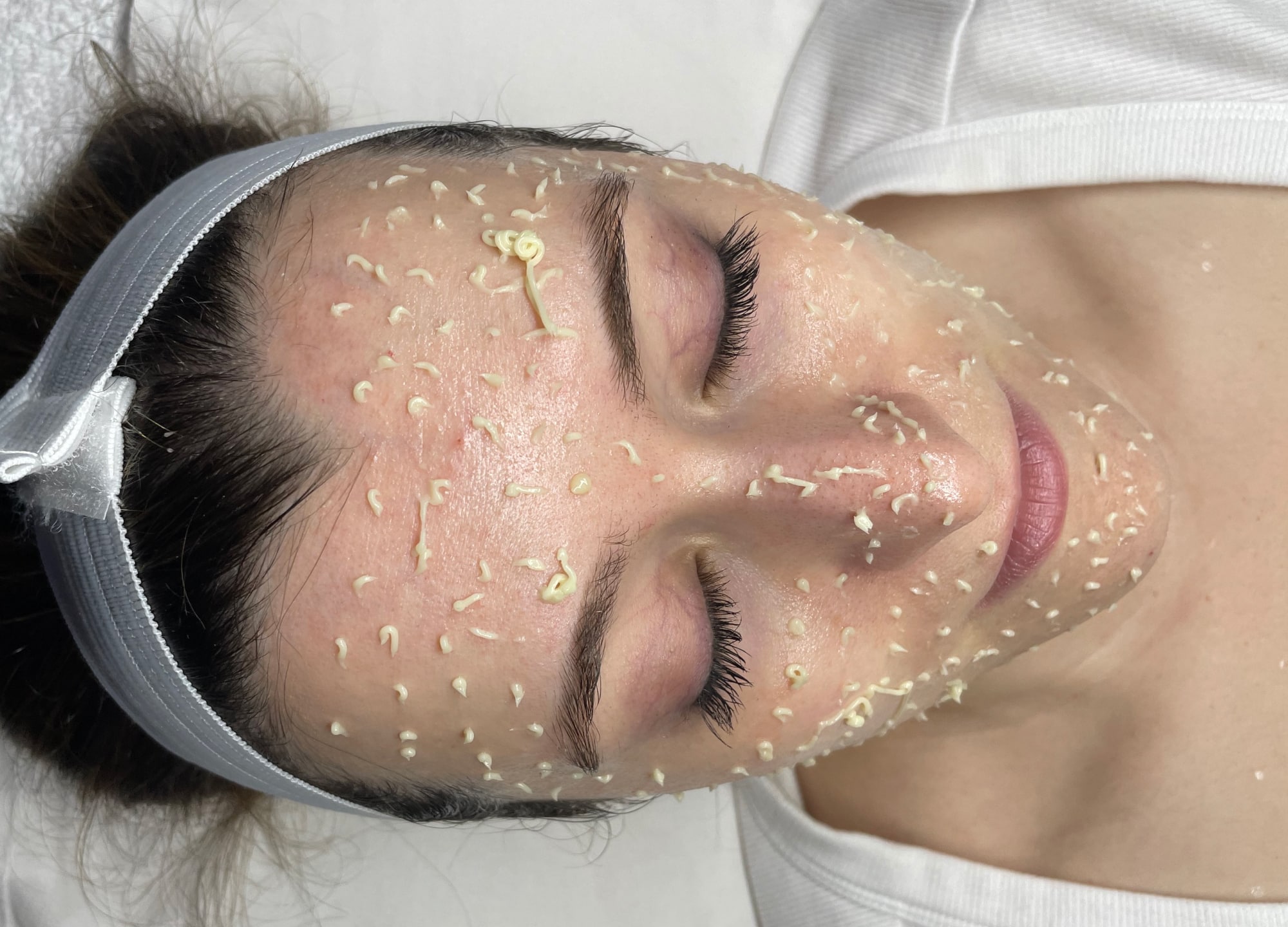Two things about me—I love trying “weird” beauty treatments (I’ll experiment with anything at least once), and I love clinically proven skin-care science. So when I learned of Beyond Miracles’s highly unique “liquid microneedling” Cellstory treatment, I had to test it for myself.
The brand’s backstory was convincing right off the bat: Holistic nutritionist and professional beach volleyball player Sara Olivova shared that after years of trying treatments from across the globe to treat her cystic acne, she found the solution on a trip to Prague. It was there she encountered a professional treatment called Cellstory and the coordinating at-home products—but they weren’t available in the United States. So she founded her own company, Beyond Miracles, becoming a CEO solely to bring the technology stateside (as you do).
While the treatment’s before and afters were impressive, it was the science behind the results that sold me. The innovation here is “microspears,” or spicules, liquid microneedles derived from freshwater sponges. These tiny needles also contain epidermal growth factor (EGF). Massaging the formula into the skin allows the microspears to penetrate the skin, stimulating collagen production twofold. Considering I’m gearing up for my wedding and am struggling with congestion (caused by stress and aging) as well as fine lines, I was curious to learn more.
I started with the at-home treatment Miracletox. This can be purchased sets of ampoules or as part of the VIP Perfection Program ($499), which includes serum, moisturizer, and masks. Each of the at-home treatment ampoules contains 10,000 microneedles, and I was duly intrigued by the completely unique prickling sensation upon application. When I touched my face the next day, I could still feel it—not on the skin’s surface but within my skin. Excited by this novel treatment, I booked a professional Cellstory treatment—which contains 50,000 microneedles—at the office of Dr. Yael Halaas, a board-certified facial plastic surgeon in New York City.
I admit, I was surprised to find this treatment at the office of a doctor, but I had yet to realize how intense Cellstory would be and that it is absolutely worth doing under the supervision of a provider (more on this later). I associate topical treatments with medspa settings. But Dr. Halaas brought it to her practice because of how advanced the research is behind the product.
The brand’s clinicals are not insignificant: A study comparing the efficacy of a treatment with spicules to that of a chemical peel of 40% glycolic acid demonstrated that not only were the liquid microneedles more effective at treating blackheads, skin dullness, redness, and discoloration than the AHA option but it significantly reduced transepidermal water loss post-procedure. In another study comparing treatment with a topical EGF product and EGF-infused spicules, the latter group showed a significant improvement in dermal density and dermal tissue depth as well as decreased wrinkle severity.
Dr. Halaas also told me that she was drawn to this treatment due to its efficacy and safety on all skin types as well as the fact that it functions as a microneedling procedure that’s needle-free. (I’m not afraid of needles, but I can certainly appreciate this added benefit.) As is the case with microneedling, you’ll see better results with increased frequency, but “patients should see an overall improvement and glow from each session within five to seven days,” says Dr. Halaas.
Ready for my glow-up, I hopped onto the treatment table of Dr. Halaas’s medical aesthetician, Brittany Blancato, who began the eight-step Cellstory ritual. This included cleansing, toning, and essence steps, which were all pleasant and fairly standard, like those you’d experience during any spa facial. Inevitably, we got to the fun part—the microspear formula, which Blancato dotted all across my face. “I’m now going to vigorously massage this in until it’s fully absorbed,” she said, “about 5 to 10 minutes.” At first, the treatment felt like a very rough scrub—anyone who’s ever overzealously used an apricot-shell-based formula knows what I’m talking about. But as time went on, the microspears started to feel sharper as the skin became more tender and the needles penetrated more deeply. I won’t lie—I wondered if this was what fiberglass feels like.
“You’re looking flushed,” said Blancato. “Is it feeling spicy?” (Unquestionably—on a scale of jalapeño to Carolina reaper, I’d say my face was at habanero.) There’s no numbing involved with this treatment, so by the end of the massage, my face felt very, very hot. Once she was done, Blancato applied a calming topical foam, then a chilled sheet mask that was a welcome moment of soothing relief.
It was right before she took the mask off that I realized I couldn’t leave wearing it, which made me nervous—how long would this tenderness and redness last? “You’re more flushed than some of the other clients I’ve had try this treatment,” Blancato warned. “The discomfort could last 72 hours. Make sure you avoid makeup for as long as possible, gently cleanse and moisturize, and wear SPF.” It was then that Blancato applied sunscreen to my face, which made me physically recoil due to how tender my face was and how prickly the needles felt in there. “You might feel the needles for several days,” Blancato added. After that, the microspears naturally expel themselves and slough off naturally with your dead skin.

I made my way to Grand Central Terminal, donning a baseball cap as it started to rain. The edge of the hat grazed my forehead, and I winced. As I made the corresponding facial expression, I winced more, feeling the needles as my face moved. Aside from the tenderness of my skin, my long train ride home was uneventful; my face started to calm down after about an hour, thanks to the air conditioning. By the next morning, the vibrant redness had faded into what looked like a sunburn. But as soon as I cleansed, the redness was back in full force—as I gently washed my face, I could feel all the microneedles under the skin’s surface, igniting the discomfort and flushing from the “vigorous massage” step of the treatment all over again. That evening, the needles became less uncomfortable, but alas, the dryness then took over.
It’s worth noting that I have never observed any kind of reaction in my skin after professional microneedling (I’ve tried Vivace, Morpheus8, and Secret RF) aside from light flushing that subsided within an hour or two. No dryness, no flaking, no real downtime. My reaction to Cellstory was totally different and closer to one I’d had after a medium-strength chemical peel, which left my face equally tender and red—and with significant peeling, which kicked in with Cellstory two days afterward.
I’d known I was dry, as I’d been layering multiple formulas on my skin in hopes of restoring some moisture but to no avail. But it wasn’t until my fiancé looked at me, trying to conceal his horror before saying, “This is the most wrinkled I’ve ever seen you” that I knew how dry I really was. I ran to a mirror, and he was right—I raised my brows, then relaxed them, but wrinkles remained behind, deeply etched into my dehydrated skin.
“Excessive dryness could come from several factors, including the seasonal sun exposure this time of year, lifestyle, and personal water intake,” says Dr. Halaas. She also pointed out that even though the formula is topical, the microspears are going far beyond the surface of the skin (and remember, deeper treatments typically cause more trauma to the skin). “One should still expect a ‘medium depth’ or epidermal-junction span of treatment reach,” she says. The epidermal junction is the structure that separates the epidermis from the dermis; fibroblasts (the cells that produce collagen) are the predominant cellular contributor to this structure. When this structure weakens and thins out, it manifests as skin aging.
Blancato noted that my skin appeared to be more sensitive during the treatment, and Dr. Halaas confirmed that skin sensitivity plays a role in dryness and recovery time. I found myself moisturizing around four or five times a day using hydrating products in my stash, including PerriconeMD High Potency Hyaluronic Intensive Hydrating Serum ($129); IT Cosmetics Confidence in a Cream ($59); and Farmacy Honey Savior All-in-One Skin Repair Salve ($34), which I applied as a slugging step. My skin stayed quite parched until day four post-procedure, when I woke up to snakelike shedding, with sizable chunks of dead skin flaking off my face.
From that aforementioned peel, I knew not to pick off the skin, though I desperately wanted to. “Whenever someone experiences peeling skin, whether mild or severe, we never want the patient to pick at the skin—this could cause further trauma or welcome unwanted bacteria to enter the tissue,” warns Dr. Halaas. “We also want to avoid this because of the increased possibility of PIH [postinflammatory hyperpigmentation] that could be triggered.”
While you can use clean manicure scissors to snip away large pieces, I opted for the other route—massaging the skin away while cleansing. I used Benefit Cosmetics The POREfessional Get Unblocked Makeup-Removing Cleansing Oil ($39) to do this because of the significant slip it offered (my skin stayed slick with it until I emulsified it with water), allowing me to really get in there and massage those flakes off. In just one or two days of doing this, nearly all the dead skin came off, save for a few areas around my hairline.
Once the dead skin was gone and my moisture levels restabilized about 10 days after my treatment, I was able to accurately assess my face and Cellstory’s results. My forehead wrinkles, which had begun to appear (my Daxxify treatment had worn off around two months prior), were nowhere to be seen. Similarly, the tiny bumps that tend to plague my forehead were gone. PIH from past blemishes along my jawline had faded, and most notably, the pronounced blackheads on my nose were dramatically reduced. I’ve had these since I was a teen, and I didn’t think anything could get rid of them, so I was shocked.

Truthfully, for 72 hours after my treatment, I was mad at myself for playing guinea pig. “I don’t know that I can do this again,” I confessed to my editor, gingerly touching my face with a fingertip to feel the needles underneath, reminding myself of that painful post-procedure cleanse. But once I’d healed, it was like I’d completely forgotten about those uncomfortable few days. My skin was even, clear, and luminous, more so than it had been after recovering from a Clear+Brilliant appointment. Sure, it wasn’t perfect, but after seeing photos from the brand, I felt pretty confident that a few more treatments could render my blackheads practically invisible, plump up my skin, and deliver a radiant glow.
Cellstory is similar to traditional microneedling, so similarly, it’s not a one-and-done treatment. You can expect to pay about $400 for one session. How many appointments you schedule will depend on your skin type and goals, but most book a series of three to six treatments, spaced about a month or so apart. “If a patient wants to do maintenance, they’re more than welcome to choose the frequency,” says Dr. Halaas. “It could be continued monthly, seasonally, twice a year, or once a year.” Call it selective memory or straight-up masochism, but I’m already in touch with Blancato about booking my next appointment.











